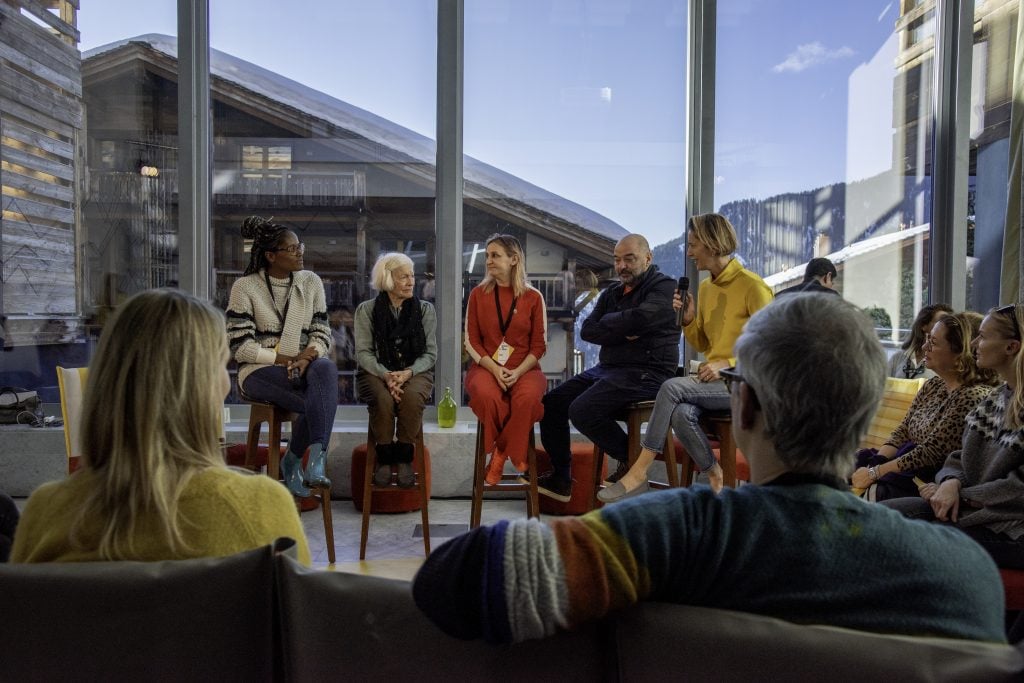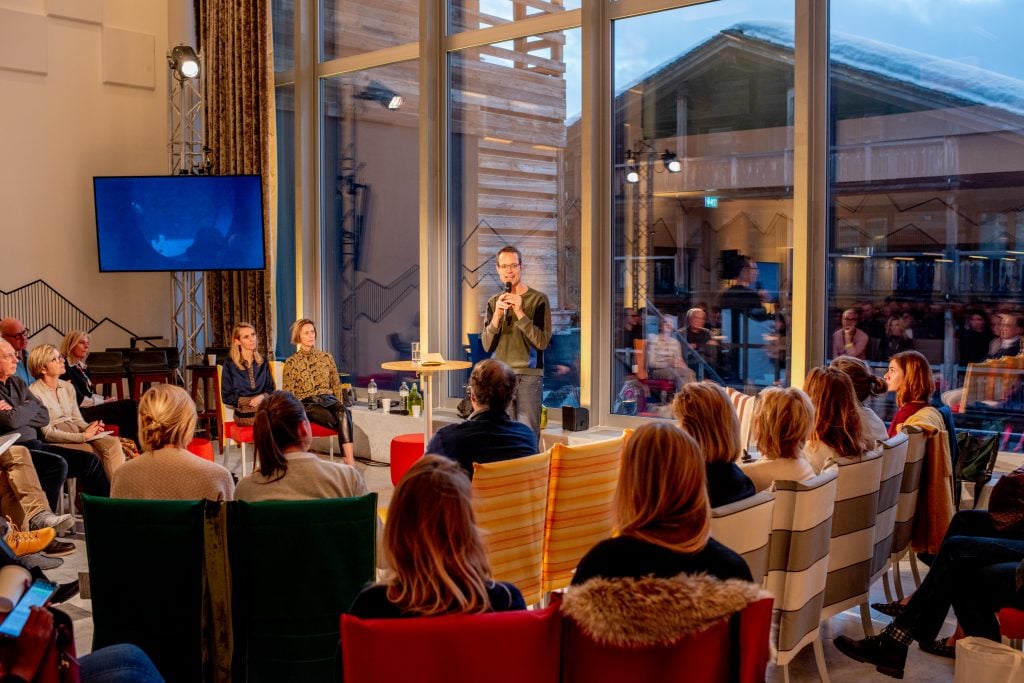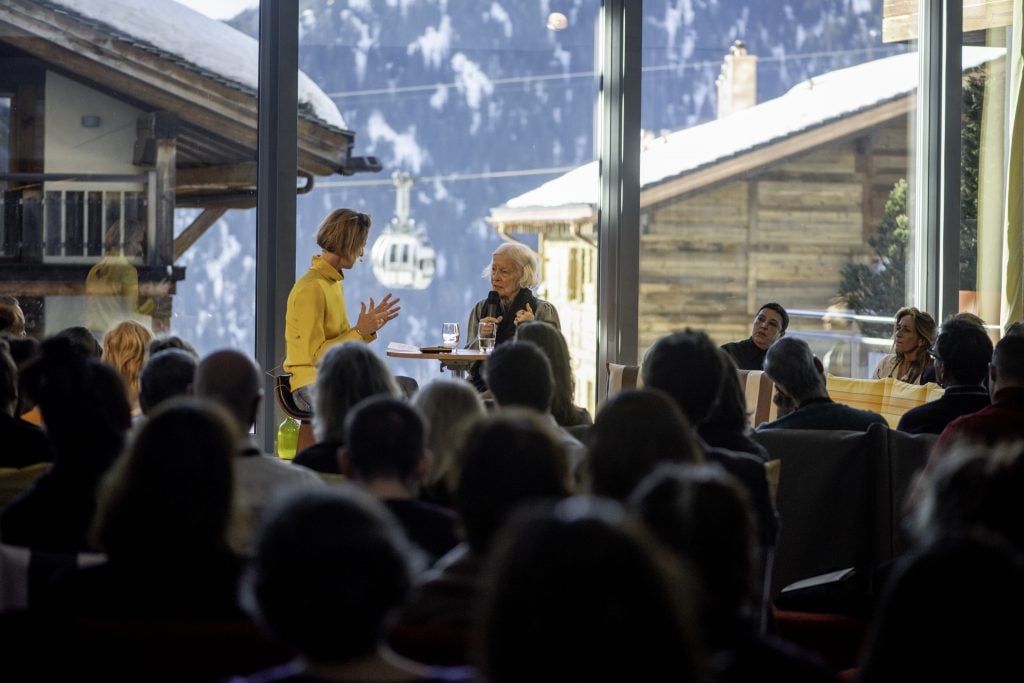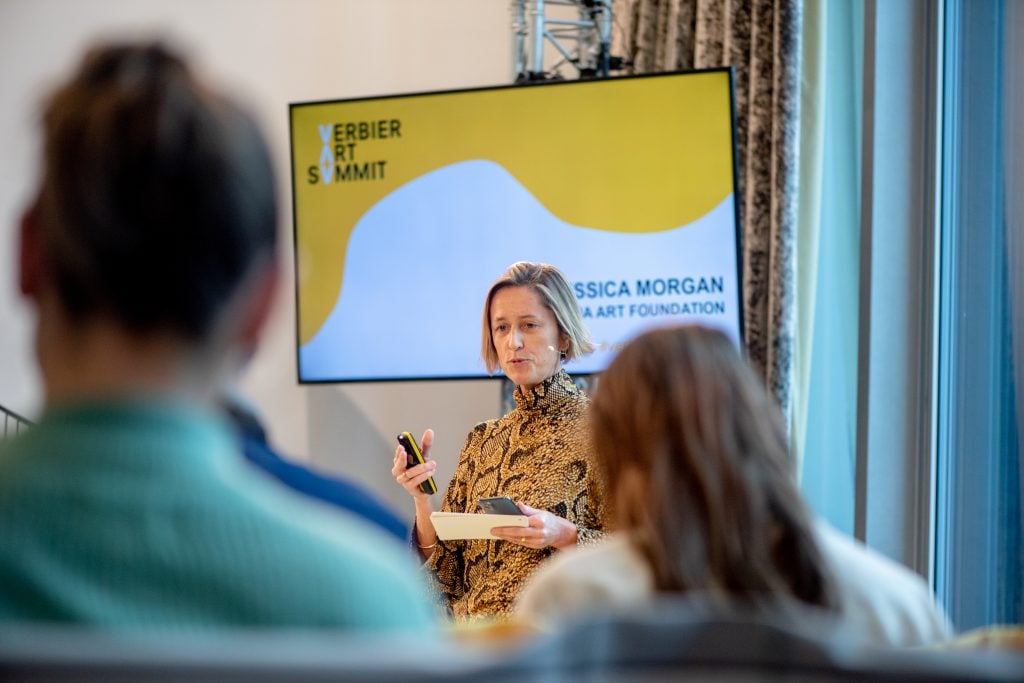On February 2, at the end of the three days of talks and discussions at the fourth Verbier Art Summit in Switzerland, I sat having breakfast with [summit director] Anneliek Sijbrandij and [Beijing-based curator] Philip Tinari discussing possible ideas for what might be the fifth summit. As flights to and from China were shutting down, Phil talked about whether to return to Beijing now or in a few weeks and joked that people were already getting nervous being around him despite the fact that he hadn’t been in China for many weeks. A crisis that remained, at that point at least, somewhat at a distance, has now permeated all our lives in a manner entirely unimaginable that morning, and it is impossible not to write through this new COVID-19 lens.
Were we really there? Undoubtedly for many, the experience of the summit is always something strangely divorced from reality. Unused to the landscape, the snow, the relative isolation, and the incredibly gracious hospitality, there is an “other worldliness” to the encounter in Verbier. It is both what distinguishes it from the many other art conversations that take place, typically in urban centers, allowing in contrast for the time and space of concentration in a remote setting, but it is also the limitation: its exclusive destination is prohibitive for so many.
What resonates in my mind most significantly as I look back on these few days together and what we learned, collectively and individually, is that what was discussed remains as urgent today as it did then. How terrible it would be were we to now be faced with the re-examination and review of a subject or concept whose relevance had vanished in the face of these material and existential concerns? To think that the already wildly privileged activity of talking together over these few days was rendered obsolete by the overwhelming events that came after, pointing to a lack of consequence in the discussion, would be hard to live with.
Instead, I have found myself coming back to experiences and conversations, presentations and films witnessed over those few days that only grow in significance. Asked to summarize what were the key lessons from Verbier, I wrote to Anneliek soon after returning to New York in early February what I thought:
That we urgently need to learn from the light touch and holistic thinking of indigenous cultures that have cared for the land for generations.
That we need to reassess the spaces, habits, structures, and systems of culture to find new ways to operate and new ways to experience.
That culture has a role to play in supporting and asserting the work and voice of thinkers, activists, and especially the young people who are demanding a new way forward.
That nothing less than a total rethink of our values is needed.

From left: Djamila Ribeiro, Joan Jonas, El Ultimo-Grito, and Jessica Morgan at the Verbier Art Summit. Djamila Ribeiro speaking at the Verbier Art Summit, 2020. ©Alpimages.
At a time when all of us in cultural institutions must closely examine our behavior and mission to reimagine a re-opening and return that will not (and should not be) the same as before, these are guidelines and concepts that I will return to in my own work as we move forward together as a team. Rather than using this time to turn inward and retreat from the questions posed in Verbier, now is the moment to reflect on how we can evolve in response to them. The phrase oft repeated by Anneliek during the summit—”do less, better”—resonates now more than ever, and as I revisit the statement for the summit, once again it reinforces the significance of what was being discussed for the current moment we find ourselves in and the future we must build.
Ahead of the summit, we reflected on the fact that subsequent to a history of Land Art, the role of the art institution had lost its way. In trying to lay out the concerns of the summit we disputed that:
While art primarily occupies space inside the institution today, buildings continue to act according to the apparent need to mark terrain through the construction of contemporary temples to culture. Unimaginable growth of collections, costly conservation needs, a business-model driven necessity to constantly expand, and vastly increased turnover has made for an industry that is both wasteful and resource hungry. Meanwhile, cultural institutions are asked publicly and programmatically to remain on the right side of the environmental debate. What are alternate models for cultural institutions? What hope is there in an environment that values spectacular containers over critical content?
Looking at the contributions of the speakers and reflecting on the conversations that took place at the summit, it is important to understand how these questions and lessons were explored. For many, the work, ideas, and approach of Joan Jonas occupied a central place in our discussions. Jonas shared imagery from her films, performance, and installation that comprise the various parts and iterations of the work Moving Off the Land. The short film featured richly associative imagery, including references to the filmmaker Jean Painlevé’s sea creatures, Moby Dick, Jonas’s own filming in aquariums, the words of Italo Calvino and Rachel Carson, as well as music by various collaborators, and poetry.
Jonas also worked with the marine biologist David Gruber, whose own film work of biofluorescent sea life and his study of the manner in which fish perceive their surroundings offered Jonas insight into further questioning the predominance of human perception. How can we understand how another species sees the world and what can we learn from this? In order to comprehend other ways of being we need to listen to and understand the other ways in which peoples, animals, and nature exist.

Adrian Lahoud at the Verbier Art Summit, 2020. ©Alpimages.
This was a refrain that was echoed volubly in the presentations of Andrea Bowers, Djamila Ribeiro, and Adrian Lahoud, who brought our attention to the fact that we ignore the centuries of knowledge of indigenous peoples at our own peril. Bowers presented the activist work of Tokata Iron Eyes, a member of the Standing Rock Sioux tribe who has been involved with the movement to stop the Dakota Access Pipeline since its inception. She continued with her own long history of documenting the work of activists in the ecological and feminist movements, bringing attention to the often overlooked or forgotten.
Ribeiro explored Brazilian indigenous beliefs that establish a different relationship to nature. If you see the plants and water as part of your existence and being, why would you cause damage to them? Echoing the complex interspecies thinking of Donna Haraway (a name rarely invoked over the summit and yet somehow present in much of the thinking), Ribeiro documented the ways in which indigenous peoples in Brazil have much for us to learn from.
Lahoud’s presentation revealed the historical and geographical knowledge of Australia’s Aboriginal people and the way in which this deep understanding of the terrain had been used to evidence a historic land claim—all the more exceptional as the case was presented in the form of a collective painting of the territory. Speaking just weeks after some of the most devastating forest fires Australia had experienced, Lahoud pointed to the evidence of Aboriginal’s deep understanding of bush fire control measures and other significant land, water, and plant management techniques through artistic depiction.

Stefan Kaegi speaking at the Verbier Art Summit, 2020. ©Alpimages.
Speaking to the absurdities of our institutional landscape and the ways in which our spaces for art and culture have evolved alongside our economies and values, Dorothea von Hantelmann, Stefan Kaegi, and El Último Grito (Rosario Hurtado and Roberto Feo), explored, in entirely different ways, the end game of the museum. Von Hantelmann traced the history of museum display and its correlation to the politics and socioeconomics of the time. If we divorce our culture from its context, how can we be surprised if we treat our ecological environment in a similarly distanced manner leading to the total absence of empathy for nature? Hurtado and Feo took the perceived absence or denial of time and its effects in the museum environment to its logical (if absurdly extreme) conclusion, envisioning the last remaining artworks circulating in space, preserved perhaps forever but never to be seen.
Staging an alternate experience from the traditional theatre, Stefan Kaegi spoke to the work of Rimini Protokol, whose experiential based performances have brought the participant/actor into a role of complicity in events, such that the divorced experience of the cultural sphere is replaced by an active participation. How do we make global environmental decisions without only prioritizing our own livelihoods? How can a mutually responsible sensibility be encouraged?
The role of architecture and the built environment, its ecological potential for change and sustainability featured in both Elvira Dyangani Ose’s talk as well as in Philippe Rahm’s. Dyangani Ose reviewed the collaborative, radical community-based actions of the Spanish collective Recetas Urbanas, who have helped to build, together with schools, parents, and citizens, temporary and permanent structures from low cost as well as recycled and found materials. Rahm explored the real potential for ecologically sound construction, building environments that respond to the given and necessary conditions rather than the typical architectural practice of creating resource hungry systems for an endlessly adaptable climate control.

Jessica Morgan and Joan Jonas at the Verbier Art Summit, 2020. ©Alpimages.
Our morning sessions ranged widely in focus but many drew inspiration from the youth movement led vocally by Greta Thunberg. Thunberg had recently attacked big banks investing in fossil fuels. Will another generation force a reconsideration of our value system? Will it come too late? Why are we not acting now? We questioned the endless movement of art and people in relation to the activities of the art world. Now that suddenly this activity has ground to a halt, let’s hope there is not a simple return to the previous delirium of art fairs, blockbuster exhibitions, and global travel, but a reminder to “do less, better.”
It is saddening that it took a virus to halt aspects of our culture that were destroying the environment and, while we can momentarily be happy about the clear skies, birdsong, and green life returning to our cities, we have to simultaneously acknowledge what else has taken hold during this time: the domination of the digital divide in all societies; the fact that this virus has affected overwhelmingly people of color and communities in poverty; that individual industries that were already destroying small-scale business and a diversity of production have now taken hold of our lives entirely; and that so many authoritarian and dictatorial governments have used this shutdown to enforce a further stranglehold on opposition and human rights.
The history of culture has been a history of marking the landscape and the cultural field has acted as witness—and often contributor to—our ecological crisis. If anything, COVID-19 has made evident that the world is connected now more than ever through trade, technology, and culture, but it is also indelibly connected through air, water, and weather patterns that pay no heed to national and political barriers. One can but hope that a moment like this is an opportunity to reset. As we re-open, re-start, resume, and return, can we do so differently, mindfully and with an urgent consideration for those most affected by this disease who are, and will be, those most affected by climate change?
Jessica Morgan joined Dia Art Foundation as director in January 2015. At Dia, Morgan is responsible for strengthening and activating all parts of Dia’s multivalent program, including its pioneering Land art projects, site-specific commissions, and collections and programming across its constellation of sites. Morgan curated the 2020 Verbier Art Summit, held on 31 January and 1 February 2020, and this text was first published in “Resource Hungry: Our Cultured Landscape and its Ecological Impact” by Koenig Books London. The Verbier Art Summit is a non-profit platform generating new ideas and driving social change through art. For more information please visit: www.verbierartsummit.org.










